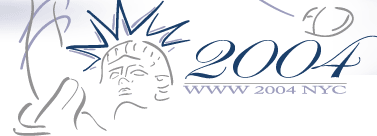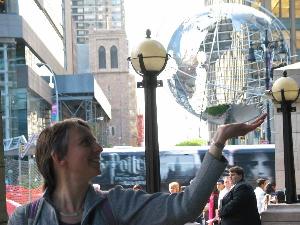 WWW 2004 trip report
WWW 2004 trip report
 WWW 2004 trip report
WWW 2004 trip report
 Discussion:
There was quite a lot of interaction and discussions during the workshop.
Discussion:
There was quite a lot of interaction and discussions during the workshop.
 The main distinction in their vision about design and annotations was that Ben votes for developing systems
The main distinction in their vision about design and annotations was that Ben votes for developing systems"Multi-Layer Active Documents for the Semantic Web"(poster version / extended version)
Vitaveska Lanfranchi, Fabio Ciravegna, Daniela Petrelli
The paper describes ideas very similar to SampLe. Their framework (documen drafting / writing / publishing / maintaining) can be easily mapped to the SampLe framework with the difference that we apply our ideas to multimedia presentatins and they work with active documents. They also explore the idea of having different annotation layers representing different levels of details. Each layer implies a corresponding visualization. With regard to that they differentiate expext/novice users. The first author will be giving a talk in our reading club scheduled for June 18.
"Is a Picture Worth a Thousand Clicks? Challenges of Adding Semantic Data to Images"
Greg Elin
Presents w3photo.org project. It was initiated with the idea to add semantic annotation to conference photo collections. The environment allows selection of different photo fragments for annotations. The paper correlates with the work done within DSTC on FilmEd project. Ronald Schroeter et. al. have developed a Vannotea tool (is described in Ronald's master thesis "Collaborative Video Indexing, Annotation and Discussion over High-Bandwidth Networks" - is available on my desk) Unless this research involves video, at the bottom level annotations are assigned to shots and fragments of shots which is similar with image annotations.
 Session: Usability and Accessibility
Session: Usability and Accessibility
There were really high quality presentations in this session
Paper: "SmartBack: Supporting Users in Back Navigation" by N. Milic-Frayling from Microsoft research et.al.
SmartBack button complements the standard back button and enables to jump directly to the key pages.
Key pages are determined based on structure of a user's navigation trails. The paper presents backgroud studies on
navigation paths and discusses implementation decision. The evaluation has shown that back button was used 3 times
more often than the SmartBack button (424 vs. 129 clicks).
Overall finding:
Other two papers from the session discuss various accessibility issues to make web content more easily availlable and adaptable for people with disabilities, elderly people or highly mobile individuals. The second paper presents interesting approach for creating audio browsable content.
Paper: "Web Accessibility: A Broader View" by John T.Richards and Vicki L.Hadson from IBM T.J. Watson Research Center, NY
Unless the paper has very "high-level" title, it discusses concrete issues about how to address common disabilities with regard to interaction problems.
Transformation and adaptation are applied to:
- font sizes and families
- spoken text
- lines and letters spacing
- colors and layouts
- keyboard (one hand, typing adjustments etc.)
- page linearization
The idea is that it should be easy for people with no or few experience with computers to make all necessary
adjustments to the content appearance. For example changing a text size for the whole page can require a number of operations
in a usual web browser. Their browser's Settings button brings up a panel where different text sizes are visually represented
which makes a selection process easier.
The evaluation has shown that this approach improved legibility and was particularly appreciated by people with developmental disabilities.
This paper can be opposed to papers describing user adaptation issues, where complicated solution are proposed.
First it stesses the point that the question of providing general accessibility is currently overlooked. And while a simple solutions can be proposed
in this direction we keep building complecated system that adapt to different user groups (where different
usually means anything but not people with specific needs for such a basic task as web browsing).
Paper: "HearSay: Enabling Audio Browsing on Hypertext Content" by I.V. Ramakrishnan et.al. Stony Brook University, NY
The paper introduces 2 key technologies: automatic partitioning of Web documents through structural and semantic analysis and usage of recently standardized VoiceXML (W3C Recommendation since March 16th) to represent voice dialogs automatically.
Session: Semantic Web ApplicationsPaper: "Building a Companion Website in the Semantic Web" by T. Miles-Board, C. Bailey, W. Hall, L. Carr, University of Southampton
The surprisingly disappointing talk by L. Carr where a lot of talking did not shed the light at the essence of work.
The idea of the paper is interesting though:
In contrast with most of the sites that provide just an electronic equivalent of a (text)book, a companion website aims to
provide an on-line support for undestanding the (text)book's content and also helps to keep the content of the book up-to-date.
They make use of Bloom's Taxonomy (a hierarchy of intellectual skills involving the acquisition and use of knowledge in the cognitive domain)
to find out the features the companion website has to offer. The authors are interested in discovering the authoring and presentation techniques
that could be employed to create "successful" companion website.
The paper contains an extensive review of companion websites with the analysis what features were or were not implemented by their developers.
The review shows that those sites provide very little support for both students and instructors groups. Besides almost non of them take a full
advantage of hypertext in order to provide better navigation.
4 techniques for authoring and presentatioin were identified which facilitate the reader's progression to the higher-level
educational objectives:
- uodate / extend the text itself;
- integrate the textbook material with other (newer) resources by linking to them;
- use hypertextual devices to expose the underlying organizational structure of the material;
- create exercises which explicitly help readers assess their learning achievements or help instructors to assess students;
The authors argue that together with these techniques the posiibilities offered by the SW should be used such as dynamically
synthesize material from different sources, use semantic services to facilitate users' activities etc.
Paper: "CS AKTive Space: Representing Computer Science in the Semantic Web" by m.c. schraefel et.al. University of Southampton
Intertaining presentation by Monica and Nigel where Monica was trying to put their work into the context of the current SW applications and Nigel was "sailing" CS AKTive Space.